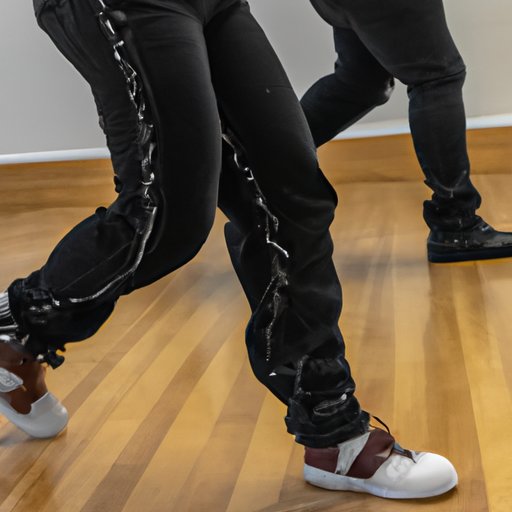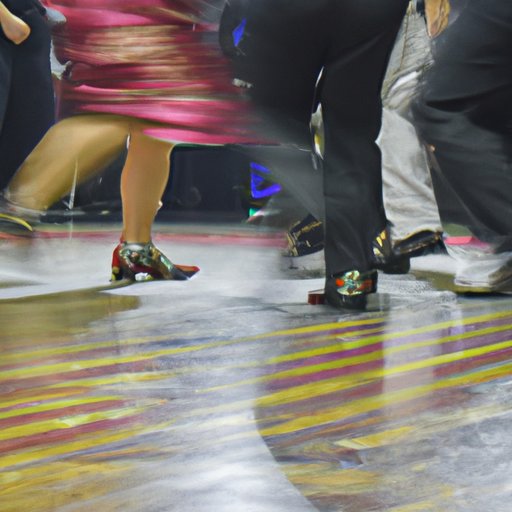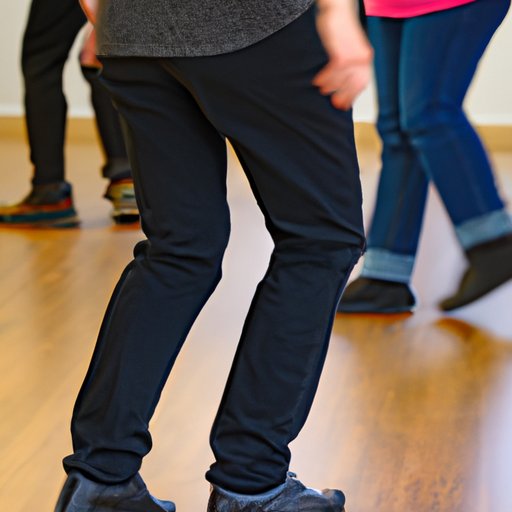Introduction
Shuffle dancing is a popular form of electronic music-driven dance that has taken over the underground dance scene in recent years. It’s one of the most popular forms of dance for young people, and it’s easy to learn and fun to do. But what exactly is shuffle dancing? Let’s take a closer look at this unique style of dance.
What is Shuffle Dancing?
Shuffle dancing is an energetic style of dance that incorporates footwork and movement patterns set to electronic music. The style of music most commonly associated with shuffle dancing is hardstyle and trance, although other genres such as drum and bass and electro house are also used. The movements themselves are based on two main components: the running man and the t-step. From these basic steps, dancers create various combinations and patterns to express themselves through their own unique style.
History and Origins of Shuffle Dancing
The history of shuffle dancing can be traced back to the late 1980s in Australia, where it was first developed as a social dance style. It quickly spread throughout Europe and North America, becoming particularly popular in the United Kingdom, Germany, France, Canada, and the United States. Since then, it has continued to evolve and become more popular, with a variety of regional styles emerging around the world.
Steps and Variations
The core steps of shuffle dancing involve alternating between the running man and the t-step. The running man involves taking a step forward with one foot and then bringing the other foot to meet it. The t-step involves taking one step forward with one foot and then taking two steps back with the other foot. These steps can be combined in various ways to create different patterns and sequences. Additionally, variations such as the crab walk and the push-up can be added to spice up the routine.
How to Master the Basics of Shuffle Dancing
Once you understand the basics of shuffle dancing, you can start to develop your own style. Here are some tips for mastering the basics of shuffle dancing:
Basic Footwork and Movement Patterns
Start by practicing the basic steps and movements of shuffle dancing until you feel comfortable. Pay attention to your feet and practice moving them in time with the music. Once you have mastered the basics, you can start to experiment with different patterns and combinations.
Timing and Musicality
In order to truly master shuffle dancing, you need to be able to move in time with the music. Listening to the beat and learning how to move with it will help you to become a better dancer. Additionally, learning how to improvise and freestyle will help you to express yourself more freely when dancing.
Developing Your Style
Once you have mastered the basics, you can start to develop your own style. Experiment with different movements and patterns and find what works best for you. Additionally, try incorporating different elements from other dance styles to make your routines even more unique. As the saying goes, “Improvise, Adapt, Overcome.”

Exploring the Different Styles of Shuffle Dancing
Different regions around the world have developed their own distinct styles of shuffle dancing. Here are some of the most popular styles of shuffle dancing:
Melbourne Shuffle
The Melbourne Shuffle is the original form of shuffle dancing that originated in Australia in the late 1980s. It is characterized by fast and intricate footwork and complex movement patterns. This style is often referred to as “hard shuffling” due to the intensity of the movements.
Los Angeles Shuffle
The Los Angeles Shuffle is a slower and more relaxed version of shuffle dancing that is characterized by smooth and flowing movements. This style is often referred to as “smooth shuffling” due to the mellow nature of the movements.
Chicago Shuffle
The Chicago Shuffle is a hybrid style of shuffle dancing that combines elements of both the Melbourne and Los Angeles styles. It is characterized by fast and intricate footwork combined with smooth and flowing movements. This style is often referred to as “hybrid shuffling” due to the combination of both styles.
Other Regional Styles
Aside from the three main styles of shuffle dancing, there are numerous other regional styles that have emerged over the years. Some of these include the New York Shuffle, the Miami Shuffle, and the London Shuffle. Each of these styles has its own unique characteristics and is worth exploring if you’re looking to expand your repertoire.
Creative Combinations: Choreographing Your Own Shuffle Dance Routines
Once you have mastered the basics of shuffle dancing, you can start to create your own routines. Here are some tips for choreographing your own shuffle dance routines:
Breaking Down Music into Sections
When creating a routine, it’s important to break down the music into sections. Listen to the track and identify the different sections, such as the intro, verse, chorus, bridge, etc. This will help you to plan out your routine and ensure that each section flows seamlessly into the next.
Crafting a Routine
Once you have identified the different sections of the track, you can start to craft your routine. Begin by creating a basic skeleton of the routine, which should include the steps and patterns you want to incorporate. Then, add transitions and variations to make the routine more interesting.
Adding Transitions and Variations
Transitions and variations are an important part of any routine. They help to keep the routine interesting and add a layer of complexity. Try experimenting with different transitions and adding variations to the steps to create a dynamic and engaging routine.

The Social Aspects of Shuffle Dancing: Community and Competitive Events
Shuffle dancing is not only a great way to express yourself, but it’s also a great way to connect with others. There are numerous local dance communities around the world that offer regular events and workshops for dancers of all levels. Additionally, there are many international dance competitions that showcase the best dancers from around the globe.

Shuffle Dancing for Health Benefits: Physical and Mental Stimulation
Shuffle dancing offers numerous physical and mental health benefits. Regularly practicing shuffle dancing can help to improve cardiovascular health, increase flexibility and balance, and enhance cognitive function. Furthermore, the social aspect of shuffle dancing can provide stress relief and help to boost mood. As Dr. Monica Borschel, a professor of Psychology at the University of Wisconsin-Madison states, “Dance is a powerful form of expression that can help individuals connect with their emotions and cope with stress.”
Conclusion
Shuffle dancing is a fun and energetic style of dance that has grown in popularity in recent years. From its history and origins to mastering the steps and exploring the different styles, this comprehensive guide to shuffle dancing covers everything from social aspects to physical and mental health benefits.
(Note: Is this article not meeting your expectations? Do you have knowledge or insights to share? Unlock new opportunities and expand your reach by joining our authors team. Click Registration to join us and share your expertise with our readers.)
